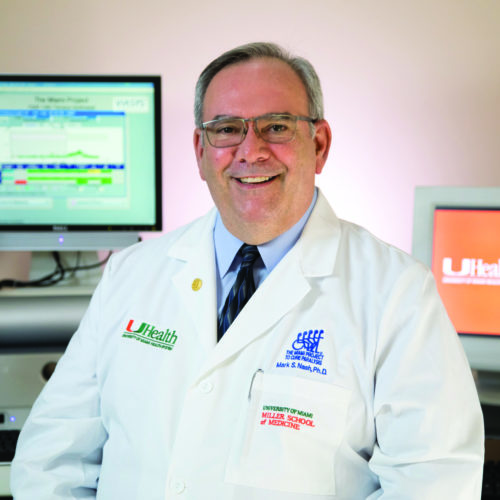Mark S. Nash, Ph.D., FACSM
Associate Scientific Director for Research, The Miami Project
Vice-Chair for Research, Department of Physical Medicine & Rehabilitation
Professor, Departments of Neurological Surgery, Physical Medicine & Medicine and Physical Therapy
Co-Director, DHHS-NIDILRR South Florida SCI Model System

The Miami Project to Cure Paralysis
1095 NW 14th Terrace (R-48)
Miami, FL 33136
Biography
Research Interests
Areas Of Research
Publications
More
Dr. Nash received his bachelor’s degree in Human Biology from the University of Toledo (1976), his Master’s Degree in Human Physiology from the same institution (1980), and his Doctoral Degree in Applied Physiology and Clinical Anatomy (1984) from the University of Toledo and Medical College of Ohio at Toledo. He spent his final year of training as a Doctoral Fellow in rehabilitation of ischemic heart diseases, and joined the faculty of the Miller School of Medicine in 1984. He is currently a tenured Professor of Neurological Surgery and Rehabilitation Medicine, with secondary appointments in the Department of Kinesiology & Sports Sciences and the Department of Physical Therapy. Dr. Nash also serves as Director of Research in Rehabilitation Medicine, and when the Miami Project was established in 1985 he was named a founding Principal Investigator and Director of the Applied Physiology Research Laboratory, a position he still holds today. Dr. Nash is a Fellow of the American College of Sports Medicine, has published more than 100 manuscripts, scholarly monographs and chapters on disability-related topics, and has delivered more than 200 national/international lectures and keynote addresses on his research themes. He is a grant reviewer for the National Institutes of Health, the US Centers for Disease Control and Prevention, the US Department of Education, and the US Department of Defense, sits on the Research Advisory Boards of four medical foundations, and serves on the federal grant agencies for 4 foreign countries. He teaches Residents and Fellows in the Department of Rehabilitation Medicine and Graduate Students in both the Departments of Physical Therapy and Kinesiology & Sports Sciences. Dr. Nash is currently Chair of the Cardiometabolic Clinical Guideline Panel for the Paralyzed Veterans Association Consortium on Spinal Cord Medicine, and Chair of the Research and Awards Committee of the American Spinal Injury Association (ASIA). He is a multiple federal awardee for grants examining causes and interventions for cardiometabolic disease after SCI, and in 2012 was honored by the American Spinal Injury Association with the David Apple Award.
Physiological Assessment of Secondary Complications following SCI: Cardiometabolic and Vascular Physiology, Cardiovascular Pathology, Exercise and Nutritional Biochemistry, Electrical Stimulation and Bionics for Movement and Health
One of the enduring goals of the Miami Project has been to test and implement treatment strategies that optimize the long-term health of persons with SCI. One strategy employed to attain this goal has been to investigate physical activity as a means of preventing medical complications that arise from physical deconditioning. In past years these studies have examined how electrically-stimulated cycling and ambulation exercise affect fitness levels in persons with tetraplegia and paraplegia. The findings of these studies support our belief that physical activity can improve fitness, heart function, and peripheral circulation, and that exercise training programs benefit the structure and function of muscle. Both direct and indirect evidence obtained from these studies suggests that exercise lowers physical and emotional stress by reducing the release of stress hormones from the adrenal glands, or altering the way in which target tissues respond to stress challenges.
There is widespread concern that the population of persons who survive SCI is aging, and that the passing of time presents an entirely new set of physical and health challenges for those who were injured years ago. We have anticipated these changes and targeted some of our research to address the effects of exercise on the functions of the heart and circulation for those who are older than 40 years. This research has also examined the naturally-occurring decline in shoulder joint function that accompanies aging with SCI as well as the disposition to heart and circulatory diseases. Results of these trials have been very encouraging, and confirm that exercise interventions are successful in reversing longstanding deconditioning and muscle weakness. Subjects involved in these trials have also benefitted by improved cardiac function at rest and during activity, and through blood lipid changes that slow the natural course of heart disease. As in our previously published findings, this work holds great promise for improving health and function while reducing disease susceptibility for those who live with SCI.
Visit Dr. Nash’s Publication Listing
News Stories
Miami Project Faculty Members Named as Fellows of ASIA (April 2022)
Dr. Mark Nash Named to ASIA Executive Board (September 2021)
Dr. Mark Nash Awarded Paralyzed Veterans Association Grant (April 2019)
Dr. Nash Receives Coulter Lifetime Achievement Award (April 2019)
The Microbiome after Spinal Cord Injury (March 2019)
Miami Project Presents Data Demonstrating Therapeutic Potential of SRK-015 in SCI (July 2017)
Are Exoskeletons Ready for Prime Time? (October 2016)
Overground Bionic Ambulation – Walking in an Exoskeleton (April 2015)
PRESENTATIONS
PROFESSIONAL AFFILIATIONS/MEMBERSHIPS
University of Miami Miller School of Medicine
Department of Neurological Surgery, The Miami Project to Cure Paralysis: Principal Investigator, Applied Physiology Research Laboratory
Department of Rehabilitation Medicine: Director of Research
Department of Kinesiology & Sports Sciences
Department of Physical Therapy
Selected External Affiliations
American College of Sports Medicine
American Congress of Rehabilitation Medicine: Member, Disability Special Interest Group and Member, Fitness & Wellness Task Force
American Spinal Injury Association: Chair, Research and Awards Committee
Paralyzed Veterans of America: Chair, Clinical Practice Guideline Panel on Cardiometabolic Diseases
Stoke Mandeville-Masson Advisory Panel
Shriners Children’s Hospital International: Rehabilitation Subcommittee and Research Advisory Board
